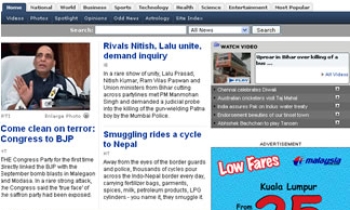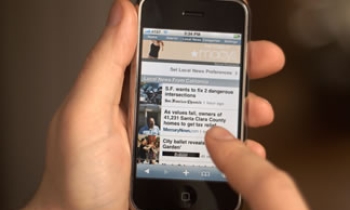So, is the new-format Guardian - neither broadsheet nor tabloid - too little, too late, or not little enough? Or has it pulled off the difficult trick of making the middle ground both radical and chic?
It's two years since the Independent and The Times tested the water as tabloids and saw their sales rise.
The Guardian decided not to, even though its sales were falling - and it has had to hold its nerve over the past 18 months as circulation continued to decline. Its editor Alan Rusbridger acknowledged that the broadsheet was too inconvenient for current lifestyles, but said the tabloid format was simply too small.
It would change the nature of the Guardian's journalism. "If you're going to edit a tabloid, whether it's upmarket or mid market or red top, you have to play the game of tabloids, which is to project simple stories very powerfully," he told the BBC. "Tabloid is very good at that.
"Our research was that people do like that kind of treatment occasionally, and once a week these papers really hit the button; but for the rest of the time they say why are you forcing this story down my throat?"
The Guardian had another problem with the tabloid format. It dominates the market for job advertising, particularly in media and the public sector, and calculated that on some days it would have needed 250 tabloid pages to accommodate all the ads.
For readers, that would have been even less manageable than the fold-and-fold-again broadsheet. Instead, it has invested £80 million in new colour presses and a complete redesign, halfway between the broadsheet and the tabloid.
The Berliner format - popular in mainland Europe - looks unfamiliar to British eyes, more so because it has colour on every page, sometimes in headlines as well as pictures. The new typeface and clean layout add to the sense of something very new.
I suspect readers will get used to it quite quickly.
With seven stories on its front page, and folded in half, it still has the feel of a broadsheet. It is a long way from the poster-style, one-story approach of the Independent's front page, which itself broke the mould but can now seem something of a straitjacket.
And it's a much more radical change than that of The Times, which tried to preserve its traditional look at the same time as halving its size.
The Guardian's new size still gives it the power of big pictures - notably in its news section, where it devotes the whole centre spread to a colour photograph of the Belfast riots, and in its 20-page Sport section.
Yet it also makes the broadsheet format - still used by the Daily Telegraph and Financial Times and several Sunday papers - feel more cumbersome.
Only the G2 feature section seems small - the page is half the size of the full paper (demi-Berliner?) and stapled, to give it the feel of a daily magazine. This may take more getting used to.
It works well for the TV listings which now get a double-page spread - though many readers may complain they are no longer on the back page where they were easy to find.
Having lagged behind its rivals in the past two years, and lost far too many sales for comfort, the Guardian has now given them a good deal to worry about. The question now is whether it can translate its new look into new readers.









